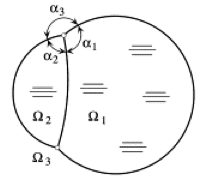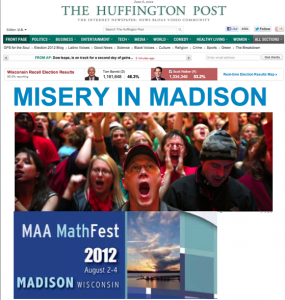Energy-minimizing Double Cells
Steve Zottoli and I, in attempting to model biological cells, came up with the following theorem on the shape of planar double cells in which the tension of an interface is a strictly convex function of the linear density. One could conjecture a similar result in 3D.
Theorem. For a double planar cell of prescribed areas A1, A2, consisting of three interfaces of prescribed mass meeting at two points, the configuration of least energy, computed for each interface as the integral of the tension with respect to arclength, is given by three circular arcs of constant density, as in Figure 1. The angles at which they meet are determined by tension equilibrium and their curvatures ki and tensions ti satisfy
k1t1 = k2t2 + k3t3.
This is the same as the energy minimizing cluster for two immiscible fluids inside a third.
Figure 1. An energy-minimizing double cell consists of three circular arcs in equilibrium. Figure from Slobozhanin and Alexander.
Remark. Even if the enclosed masses instead of areas are prescribed, the minimizer will still be minimizing for whatever areas it has and will hence have the stated form. If total mass rather than the mass of each interface is prescribed, then each interface will have the same density and tension and the double cell will be the same as the energy minimizing soap bubble cluster, with angles of 120 degrees.
Proof. A minimizer has constant density on each interface (because on any fixed curve of prescribed mass, constant density uniquely minimizes energy, because tension is a strictly convex function of density). Circular arcs are best. A fortiori, the minimizer minimizes weighted length, with a different weighting constant for each interface, which is the immiscible fluids problem.
Remark. The immiscible fluids problem can be posed in great generality in geometric measure theory [M1, Chapter 16], allowing very general, disconnected regions. That the minimizer still takes the above form can be proved by the same simple argument that Hutchings [M2] provided for the case when all weightings are equal, the “double soap bubble problem,” as was pointed out by Cotton and Freeman [CF, §2.1].
[CF] Andrew Cotton and David Freeman, The double bubble problem in spherical and hyperbolic space, Intern. J. Math. Math. Sci. 32 (2002) 641-699.
[M1] Frank Morgan, Geometric Measure Theory: a Beginner’s Guide, Academic Press, third edition, 2000.
[M2] Frank Morgan, Proof of the double bubble conjecture, Amer. Math. Monthly 108 (March 2001) 193-205.




 Welcome to my blog. I also have a blog at the
Welcome to my blog. I also have a blog at the